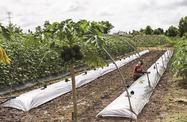A plan for Brunei Darussalam to become 60% self-sufficient in rice production by 2015 may at first glance seem an overly optimistic goal, but with a little assistance from several of the Sultanate’s neighbours, the country could be on the way to greater food security for its staple crop.
The plan, announced by His Majesty the Sultan in 2009, was to expand the country’s cultivated area for rice from 1300 ha in 2009 to 4500 ha in 2010, as well as to achieve 20% self-sufficiency in rice production in 2010. The expectation was for the 2010 harvest to reach 5800 tonnes.
Yet in March 2011, the minister of industry and primary resources (MIPR), Pehin Yahya Bakar, said that the country had not been able to meet the 20% self-sufficiency goal. Yahya said that although production levels were up from the 3.1% of total needs met in 2007, 2010’s output was lower than had been anticipated. He did not disclose the exact figure.
Since then, however, some of the Sultanate’s Asian neighbours have come in to try and help boost yields. In 2009, the most recent year for which official statistics are available, Bruneians’ rice consumption equalled 31,786 tonnes per year, with average per-capita consumption totalling 78.25 kg. Rice imports for the year totalled 31,708 tonnes.
Agriculture in the Sultanate still lags behind other sectors of the economy. According to the CIA World Factbook, the agricultural sector makes up only 4% of Brunei Darussalam’s labour force and less than 1% of GDP. This compares with 63% and 72% in the industrial sector and 33% and 27% in the services sector, respectively.
Meanwhile, the Sultanate’s some 400,000 people live in a 5765-sq-km territory, of which only a little more than 2% is arable land. Added to this, in 2010, 76% of the population lived in urban areas, leaving very few people to tend the soil.
So, although Brunei Darussalam is home to many natural resources – most notably, oil and natural gas – it currently does not have enough land or labour to engage in large-scale agricultural activities. Combined with this paucity of arable land, any rice strain that is grown must be of a high-yield variety.
The Philippines, Taiwan and Singapore are just a few of the countries with long histories of rice-growing expertise that have offered to help by providing high-yield rice varieties, as well as technology transfer, capacity building and training.
A good example of how outside help has boosted Brunei Darussalam’s rice yields is agricultural cooperative Koperasi Setiakawan (KOSEKA), whose yields of the hybrid Laila variety rice have increased from about 100 tonnes in 2008 to more than 1000 tonnes in 2011.
According to the MIPR, the basis for KOSEKA’s success is attributed to KOSEKA members’ attendance at Brunei Darussalam’s Rice Farmers Field School (RFFS), established in 2010 to train farmers in effective crop and pest management.
The RFFS grew out of a 2009 memorandum of understanding (MoU) on agricultural cooperation between Brunei’s Department of Agriculture and Agrifood (DAA) and the Philippines’ PhilRice, a governmental rice research and development agency. RFFS students are taught best farming practices through techniques such as agro-ecosystem analysis, a system that helps farmers improve their decision-making abilities.
Furthermore, Taiwan has produced a collection of nine new varieties of rice from which Brunei can select the best for its fields. “We are willing to take part in Brunei’s important national rice project and help Brunei develop scientific agriculture and build quality agricultural industry in the near future,” Terry Ting, a representative of the Taipei Economic and Cultural Office in Brunei, told the Brunei Times in October 2011.
Another helping hand came in September 2011 when Japan’s Mitsubishi Corporation and the DAA entered into a MoU to improve cultivation techniques and methods of fertiliser application in the Temburong, Tutong and Brunei-Muara districts.
Additionally, Singapore-based SunLand Agri-Tech has been assisting the government since 2009 in the development of hybrid rice strains. A key difference here is that SunLand is not selling the Sultanate the high-yield rice seeds; rather, it is training the country to develop the variety itself.
Another viable option for Brunei Darussalam to ensure its food security involves entering into joint ventures that will enable it to own and operate farms in neighbouring countries. “There have been proposals from other countries, such as the Philippines, Indonesia and even Malaysia, to invite us to look at farms and facilities for a possible joint venture or possible ownership and production there,” MIPR’s Yahya told the Brunei Times last March.
With so many options to choose from, and with its neighbours so willing to step in to help, Brunei Darussalam stands a good chance of at least partially meeting its food security targets in the next three years.

